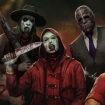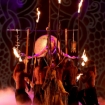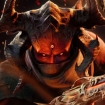It doesn't take long to realize that Death's Gambit is one of the most authentically metal indie games released in quite some time. Just check out the fifth boss: Your microscopic, black-iron knight squares off with an infernal, moss-covered giant that's literally modeled to be about 100-times your size. The boss itself is called the Forgotten Gaian, and it is awesome, a true tribute to the excesses of medieval folklore, and the exact sort of beastly you'd expect to be immortalized on a cover of one of those Eighties Celtic Frost albums. Seriously, few games let you feel like you're playing through a reanimated barrage of black-metal record cover sleeves, but Death's Gambit nails that feeling to the T.
The game, which was published last month by Adult Swim, follows the tropes established by the broader traditions established by From Software's Dark Souls and Demon's Souls games. The player occupies a fallen low-fantasy kingdom, occupied primarily by bloodthirsty cretins, and you do their best to survive through chunky melee combat and crafty dodges. You know, that bait-and-punish swordplay you're probably extremely familiar with at this point. There are also some inventory management and character-building elements, in case you're worried that the RPG part of this RPG fell by the wayside.
Of course, what distinguishes Death's Gambit from other games like it is the sheer complexity, and beauty, of the art direction and sprite work. Alex Kubodera, lead artist and creative director for the game, drummed up a truly outstanding suite of landscapes and enemy designs. You'll find ghoulish catacombs, snowbound shrines and wretched beasties who wear their ill intentions right on their skull-capped faces. It's all meticulously decorated and layered, and it does a fantastic job of demonstrating exactly how inhospitable and unwelcoming this realm can be.
However, the most impressive part of Death's Gambit might be the sense of scale Kubodera managed to muster. The Forgotten Gaian isn't the first time a massive boss encounter has been implemented into a 2D game, but it still looks bigger, and more foreboding, than pretty much any other enemy I can remember. When I reached Kubodera over email, he told me that feeling was one the first things he wanted to capture - to keep taking the audience's breath away at every turn.
"Scale was accomplished quite literally through the size of assets in game," says Kubodera. "We deliberately keep the camera fairly zoomed in so the combat feels punchy and you can see your actions. But for moments where we want to show off the size of the world or its creatures, we zoom the camera further and further out. It's a real challenge to draw, just because you have to account for vertical space the players may not see unless they jump off from a certain height. It exponentially increases the canvas size, and stresses memory usage. The badassness, I don't think, was limited by 2D in any way. As long as the character designs and environments are strong, the way it's represented doesn't really matter."
While Kubodera tells me that the art design for Death's Gambit wasn't specifically influenced by heavy metal, it was drawn from a few heavy metal–adjacent things. For instance, after you defeat the Gaien, you'll be pitted against an abomination called The Dark Knight, who wields a sinewy sawbone sword on a disgusting protrusion of oily spikes along his back. You face off with him in pitch-blackness, which makes the combat particularly nervy. Naturally, The Dark Knight's armor was specifically inspired by Guts, the protagonist from the classic Japanese manga series Berserk, which is also easily one of the most heavy-metal comic series of all time. (If you're unfamiliar, just take one look at a splash panel and you'll see why.) "The whole idea of cults, death and sacrifices is an ever-present theme in Death's Gambit, though," continues Kubodera. "There were certainly moments where we strived to pull off a gothic creepiness with color."
We'd be remiss to not touch on Death's Gambit's score, which ranges from tranquil hymnals, to deranged choral barrages, to sweeping, misty-eyed reprises to pair with its moments of making its character feel very small. Occasionally, you can also find some Spanish guitar or a bit of synth, as symbolic touches to tell you a little bit about the history of this very dead place. "What was important was for the music to fit the scene, and I think [composer] Kyle Hnedak accomplished that beautifully," adds Kubodera. When asked what rock band he'd recommend to anyone playing through Death's Gambit right now, he quickly responds, "Linkin Park."
You know what? That actually makes sense. When you're pressed against resources and out of options, when you're trying to kill ancient things that can crush you like a bug, when you're holding out hope in a world that's long surrendered to an immortal, encroaching sense of evil, you could do a lot worse than Hybrid Theory for your soundtrack.
Death's Gambit is out right now, and you can buy it for $19.99 on the Steam store.











